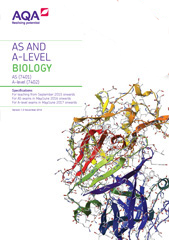Mathematical requirements and exemplifications
In order to be able to develop their skills, knowledge and understanding in Biology, students need to have been taught, and to have acquired competence in, the appropriate areas of mathematics as indicated in the table of coverage below.
Overall, at least 10% of the marks in assessments for biology will require the use of mathematical skills. These skills will be applied in the context of biology and will be at least the standard of higher tier GCSE mathematics.
The following tables illustrate where these mathematical skills may be developed during teaching or could be assessed. Those shown in bold type would only be tested in the full A-level course.
This list of examples is not exhaustive. These skills could be developed or assessed in other areas of specification content. Other areas where these skills could be developed have been exemplified throughout these specifications.
Arithmetic and numerical computation
Mathematical skills |
Exemplification of mathematical skill in the context of Biology |
|
|---|---|---|
MS 0.1 |
Recognise and make use of appropriate units in calculations |
Students may be tested on their ability to:
|
MS 0.2 |
Recognise and use expressions in decimal and standard form |
Students may be tested on their ability to:
|
MS 0.3 |
Use ratios, fractions and percentages |
Students may be tested on their ability to:
|
MS 0.4 |
Estimate results |
Students may be tested on their ability to:
|
MS 0.5 |
Use calculators to find and use power, exponential and logarithmic functions |
Students may be tested on their ability to:
|
Handling data
Mathematical skills |
Exemplification of mathematical skill in the context of Biology |
|
|---|---|---|
MS 1.1 |
Use an appropriate number of significant figures |
Students may be tested on their ability to:
|
MS 1.2 |
Find arithmetic means |
Students may be tested on their ability to:
|
MS 1.3 |
Construct and interpret frequency tables and diagrams, bar charts and histograms |
Students may be tested on their ability to:
|
MS 1.4 |
Understand simple probability |
Students may be tested on their ability to:
|
MS 1.5 |
Understand the principles of sampling as applied to scientific data |
Students may be tested on their ability to:
|
MS 1.6 |
Understand the terms mean, median and mode |
Students may be tested on their ability to:
|
MS 1.7 |
Use a scatter diagram to identify a correlation between two variables |
Students may be tested on their ability to:
|
MS 1.8 |
Make order of magnitude calculations |
Students may be tested on their ability to:
|
MS 1.9 |
Select and use a statistical test |
Students may be tested on their ability to select and use:
|
MS 1.10 |
Understand measures of dispersion, including standard deviation and range |
Students may be tested on their ability to:
|
MS 1.11 |
Identify uncertainties in measurements and use simple techniques to determine uncertainty when data are combined |
Students may be tested on their ability to:
|
Algebra
Mathematical skills |
Exemplification of mathematical skill in the context of Biology |
|
|---|---|---|
MS 2.1 |
Understand and use the symbols: =, <, <<, >>, >, , . |
No exemplification required. |
MS 2.2 |
Change the subject of an equation |
Students may be tested on their ability to:
|
MS 2.3 |
Substitute numerical values into algebraic equations using appropriate units for physical quantities |
Students may be tested on their ability to:
|
MS 2.4 |
Solve algebraic equations |
Students may be tested on their ability to:
|
MS 2.5 |
Use logarithms in relation to quantities that range over several orders of magnitude |
Students may be tested on their ability to:
|
Graphs
Mathematical skills |
Exemplification of mathematical skill in the context of Biology |
|
|---|---|---|
MS 3.1 |
Translate information between graphical, numerical and algebraic forms |
Students may be tested on their ability to:
|
MS 3.2 |
Plot two variables from experimental or other data |
Students may be tested on their ability to:
|
MS 3.3 |
Understand that represents a linear relationship |
Students may be tested on their ability to:
|
MS 3.4 |
Determine the intercept of a graph |
Students may be tested on their ability to:
|
MS 3.5 |
Calculate rate of change from a graph showing a linear relationship |
Students may be tested on their ability to:
|
MS 3.6 |
Draw and use the slope of a tangent to a curve as a measure of rate of change |
Students may be tested on their ability to:
|
Geometry and trigonometry
Mathematical skills |
Exemplification of mathematical skill in the context of Biology |
|
|---|---|---|
MS 4.1 |
Calculate the circumferences, surface areas and volumes of regular shapes |
Students may be tested on their ability to:
|
